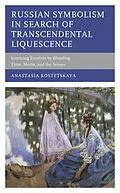The book examines Russian symbolist texts and turns the focus from their traditional historic-cultural interpretations to analyze the symbolist cognitive aesthetics-aesthetics that govern links between poetry, art, and cinema and the sensory-emotional imagery they evoke. This aesthetics inextricably map mystical transcendence to a spiritual world-a realibus ad realiora-through fluid transmutation. Anastasia Kostetskaya presents an innovative cross-disciplinary analysis of iconicity-a relationship of resemblance between the artistic form and its meaning, the possibilities of which symbolist artists explored to create sublime emotional experiences for the reader or viewer. She challenges the strictly dualistic and hierarchical terms of traditional symbolist concepts. This study demonstrates that this counterdualistic tendency cognitively extends from liquescence-a perception of fluid continuity between people and water. This analysis of interconnected symbolist media shows how symbolists rely on blending in their attempts to engender emotional flux through the pliable form. Fusing cognitivist and historic-cultural approaches in fluidly connected art modes, this book represents chronological, conceptual, and aesthetic continuity from poetry by Konstantin Bal'mont (1867-1942), paintings by Viktor Borisov-Musatov (1870-1905), and cinematography by Evgenii Bauer (1865-1917).
Autorentext
Anastasia Kostetskaya is assistant professor of Russian at the University of Hawaii at Manoa.
Inhalt
Introduction: Symbolist Arts as Forms Symbolic of Human Feeling
Chapter One: Liquescence: The Master Metaphor for Blending Strategies
Chapter Two: In Boundlessness: The Ocean of Surging Emotion in Konstantin Bal'mont's Cognitive Poetics
Chapter Three: Quiet Flows the Soul across the Boundless and Beyond: Viktor Borisov-Musatov's Symbolist Painting
Chapter Four: Symbolism in Flux: The Moving Image as Transcendent Emotion
Afterword: he Dying Swan: The Transcendent Body Image on Symbolist Screen
